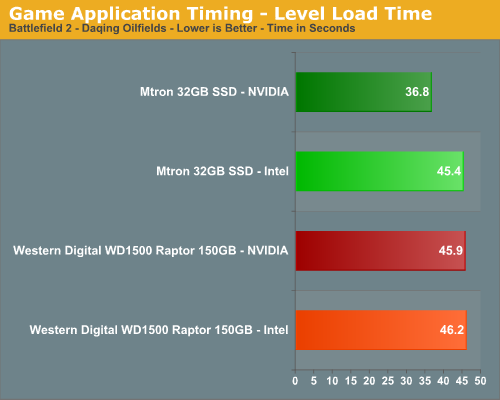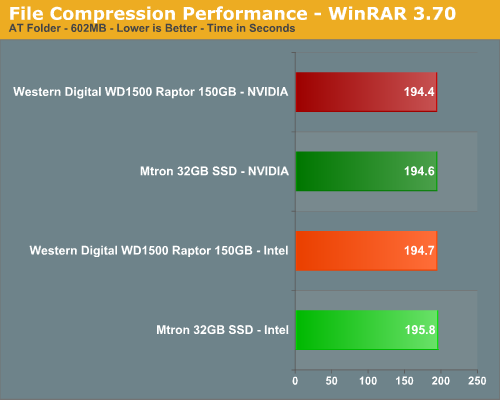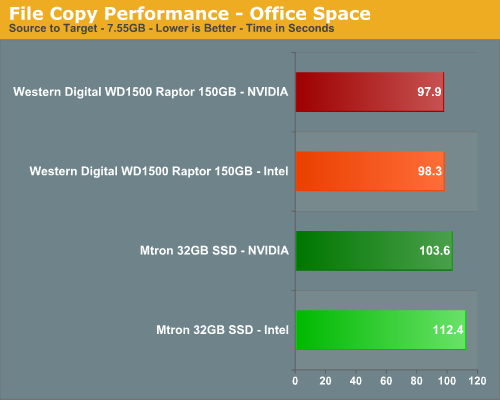MTRON SSD 32GB: Wile E. Coyote or Road Runner?
by Gary Key on August 15, 2007 3:00 AM EST- Posted in
- Storage
Actual Application Performance
Our application benchmarks are designed to show application performance results with times being reported in seconds, with lower scores being better. While these tests will show differences between the drives it is important to understand we are no longer measuring the synthetic performance of the hard drive but how well our test platforms perform with each individual drive. The performance of a drive is an integral part of the computer platform but other factors such as memory, CPU, core logic, and even driver choice can play a major role in determining how well the drive performs in any given task.
Game Level Load
This test centers on the actual loading of a playable level within our game selection. It is obvious based on the drive's specifications that this drive could be used in a gaming system, though its capacity severely limits the amount of newer multi-Gigabyte titles you can load on it. We have found in gaming that the burst/sustained read speed and access time of a drive is very important. Considering SSDs excel in low access (latency) times we thought it would be interesting to see how well this drive performs in one of our more demanding game tests. The Battlefield 2 test measures the time it takes to load the Daqing Oilfields level. Our application timer begins when the start single player icon is initiated and ends when the join game icon is visible.

This is one of the more demanding game level load times we test currently and the MTRON drive scores first, although the margin is minimal with the Intel chipset. Our NVIDIA based board loads this particular level 8.6 seconds faster than the Intel board, resulting in a 20% improvement over the Raptor. After several hours of game play we could definitely tell a difference between the two drives in this test. The MTRON SSD product always seems to load the levels in a smoother manner than our Raptor although it is difficult to determine any actual speed differences except when first starting the game. The lack of hard drive noise is a welcome relief when playing games with the MTRON drive.
Nero Recode
Our encoding test is quite easy - we take our original Office Space DVD and use AnyDVD Ripper to copy the full DVD to the hard drive without compression, thus providing an almost exact duplicate of the DVD. We then fire up Nero Recode 2, select our Office Space copy on the hard drive, and perform a shrink operation to allow the entire movie along with extras to fit on a single 4.5GB DVD disc. We leave all options on their defaults except we turn off the advanced analysis option. The scores reported include the full encoding process and are represented in seconds, with lower numbers indicating better performance.

This test is primarily dependent on CPU performance but the write performance of a drive can make small but measurable differences in completion times. As in our PCMark05 tests, the write performance of the MTRON drive does not match that of our Raptor and the resulting performance is about 6% slower than the Raptor. We typically find in this particular test that the CPU throughput of the Intel chipsets is a little better than the NVIDIA chipsets and our Raptor results bear this out. However, due to the better write speed performance of the NVIDIA chipset with the MTRON drive, we see it scoring ahead of the Intel solution even with the CPU throughput disadvantage.
WinRAR 3.70
Our WinRAR test measures the time it takes to compress our test folder that contains 444 files, 10 folders, and 602MB of data. While the benchmark is CPU intensive for the compression tests it still requires a fast storage system to keep pace with the CPU. A drive that offers excellent write performance can make a slight difference in this benchmark.

This test relies on the CPU and also the burst rates of the storage system. Even handicapped with a 36% lower burst speed and 6% lower write speeds, the MTRON drive is basically even with the Raptor. The difference between the NVIDIA and Intel chipsets with the MTRON drive is only 1% in this test. In other words, WinRAR file compression - even with a fast CPU - is so limited by CPU and memory performance that hard drive speed rarely comes into play.
File Copy Performance
Our file copy test measures the time it takes to transfer our test folder that contains 29 files, 1 folder, and has 7.55GB of data from our source drive to the target test drive. This benchmark is disk write intensive and requires a fast storage system.

We finish our application tests with a benchmark that favors the Raptor drive because it represents a pure write scenario. As in PCMark05 where the largest differences in scores were generated with the write tests, we see the SSD product being up to 13% slower. However, that margin is only 6% when comparing the results with the NVIDIA chipsets as the MTRON drive is almost 8% slower on the Intel chipset.
Our application benchmarks are designed to show application performance results with times being reported in seconds, with lower scores being better. While these tests will show differences between the drives it is important to understand we are no longer measuring the synthetic performance of the hard drive but how well our test platforms perform with each individual drive. The performance of a drive is an integral part of the computer platform but other factors such as memory, CPU, core logic, and even driver choice can play a major role in determining how well the drive performs in any given task.
Game Level Load
This test centers on the actual loading of a playable level within our game selection. It is obvious based on the drive's specifications that this drive could be used in a gaming system, though its capacity severely limits the amount of newer multi-Gigabyte titles you can load on it. We have found in gaming that the burst/sustained read speed and access time of a drive is very important. Considering SSDs excel in low access (latency) times we thought it would be interesting to see how well this drive performs in one of our more demanding game tests. The Battlefield 2 test measures the time it takes to load the Daqing Oilfields level. Our application timer begins when the start single player icon is initiated and ends when the join game icon is visible.

This is one of the more demanding game level load times we test currently and the MTRON drive scores first, although the margin is minimal with the Intel chipset. Our NVIDIA based board loads this particular level 8.6 seconds faster than the Intel board, resulting in a 20% improvement over the Raptor. After several hours of game play we could definitely tell a difference between the two drives in this test. The MTRON SSD product always seems to load the levels in a smoother manner than our Raptor although it is difficult to determine any actual speed differences except when first starting the game. The lack of hard drive noise is a welcome relief when playing games with the MTRON drive.
Nero Recode
Our encoding test is quite easy - we take our original Office Space DVD and use AnyDVD Ripper to copy the full DVD to the hard drive without compression, thus providing an almost exact duplicate of the DVD. We then fire up Nero Recode 2, select our Office Space copy on the hard drive, and perform a shrink operation to allow the entire movie along with extras to fit on a single 4.5GB DVD disc. We leave all options on their defaults except we turn off the advanced analysis option. The scores reported include the full encoding process and are represented in seconds, with lower numbers indicating better performance.

This test is primarily dependent on CPU performance but the write performance of a drive can make small but measurable differences in completion times. As in our PCMark05 tests, the write performance of the MTRON drive does not match that of our Raptor and the resulting performance is about 6% slower than the Raptor. We typically find in this particular test that the CPU throughput of the Intel chipsets is a little better than the NVIDIA chipsets and our Raptor results bear this out. However, due to the better write speed performance of the NVIDIA chipset with the MTRON drive, we see it scoring ahead of the Intel solution even with the CPU throughput disadvantage.
WinRAR 3.70
Our WinRAR test measures the time it takes to compress our test folder that contains 444 files, 10 folders, and 602MB of data. While the benchmark is CPU intensive for the compression tests it still requires a fast storage system to keep pace with the CPU. A drive that offers excellent write performance can make a slight difference in this benchmark.

This test relies on the CPU and also the burst rates of the storage system. Even handicapped with a 36% lower burst speed and 6% lower write speeds, the MTRON drive is basically even with the Raptor. The difference between the NVIDIA and Intel chipsets with the MTRON drive is only 1% in this test. In other words, WinRAR file compression - even with a fast CPU - is so limited by CPU and memory performance that hard drive speed rarely comes into play.
File Copy Performance
Our file copy test measures the time it takes to transfer our test folder that contains 29 files, 1 folder, and has 7.55GB of data from our source drive to the target test drive. This benchmark is disk write intensive and requires a fast storage system.

We finish our application tests with a benchmark that favors the Raptor drive because it represents a pure write scenario. As in PCMark05 where the largest differences in scores were generated with the write tests, we see the SSD product being up to 13% slower. However, that margin is only 6% when comparing the results with the NVIDIA chipsets as the MTRON drive is almost 8% slower on the Intel chipset.










37 Comments
View All Comments
enovikoff - Thursday, October 29, 2009 - link
I purchased two 7000 series SSDs for running a commercial datacenter (hey, they're billed as "enterprise") Both failed within 3 months and MTRON did not stand behind them. Instead they said that I should mail them to Korea(!!!) and wait to see if their tests indicated that they were defective. In my business "waiting" means I either have to spend money to replace the hardware or leave my customers high and dry. Attempts to RMA the SSDs through their reseller, NeoStore, also failed: NeoStore took the SSDs back and then never acknowledged emails or calls. $2000 worth of hardware (I have receipts/invoices to prove everything) is in their possession, and my company is out the $2000 as well as the refunds we had to pay our customers for the downtime.Avoid MTRON: they're not ready to provide reliable units or do business in the United States.
WaterGun - Thursday, August 16, 2007 - link
The same drive is for sale in Japan for only 99800 Yen ~ US$900. Here is a list of online shops:http://www.3top.co.jp/shohin_ichiran.php?SearchMod...">3 Top
http://shop.tsukumo.co.jp/goods/4582149901982/2015...">Tsukumo
http://www.ark-pc.co.jp/item/MSD-SATA602532/code/1...
So, why is there such a big price difference? Any takers?
brundlefly - Friday, August 17, 2007 - link
Hmmm there should be some kind of service that helps you order from Japanese web sites.PrinceGaz - Thursday, August 16, 2007 - link
Presumably, the 32GB SSD is measured using binary GB (1,073,741,824 bytes) rather than decimal GB like traditional hard-drives, therefore making it roughly 34.3GB when comparing it to other hard-drives. Still a bit on the small side, but perhaps worth mentioning.brundlefly - Thursday, August 16, 2007 - link
fdisk shows the device as 33.2 GB, but formatted as ext3 df shows ~31GB available.Disk /dev/sda: 33.2 GB, 33285996544 bytes
255 heads, 63 sectors/track, 4046 cylinders
Units = cylinders of 16065 * 512 = 8225280 bytes
df .
Filesystem 1K-blocks Used Available Use% Mounted on
/dev/sda5 31981396 8893912 21462916 30% /mnt/mtron
brundlefly - Thursday, August 16, 2007 - link
I received one of these this week too for evaluating as a MySQL datadir.The results were outstanding - we had a handful of problem queries which would take 30-40 seconds on a 15k Fujitsu MAS Ultra SCSI. The same queries take about 3 seconds on the MTRON.
I have worked with large MySQL databases for years, but there are a lot of examples like this one where I just cant qualify throwing a few days into A/B testing various indexing and table schemas for the performance issues with a handful of slow queries - especially when just *loading* a table and creating an index can take 20-30 min each. Throwing hardware at the problem is far cheaper and you can use simpler table layouts, plus you may not even be able to achieve this performance any other way in some scenarios.
IMHO this is a unique 'drop-in' solution for a lot of specific data center applications. In the long term you are going to see these replace mechanicals across the board in the server room because they will be cheaper and far simpler to deal with then SCSI and offer far better performance with low heat, noise, and power.
I also popped it in my notebook, which was just sublime. I already had the fastest mechanical in this notebook - a brand new Hitachi 7k200 with 16MB cache.
Within 34 min I had a 32-bit Vista Ultimate / Ubuntu Feisty x64 dual-boot setup - Vista booted in 21 seconds, Ubuntu in a little under 30 (a savings of about 6 seconds for each). No noise, vibration, or heat - the fan never came on, even set to high performance power profile. I didnt do a battery life test but from the battery remaining indicator I would expect an extra half hour.
Immediately the advantages of having a .1ms access time became apparent. Stuff just happens. Firefox cold boots in 3s, open a bunch of apps - the disk doesnt care, every piece of data is exactly .1ms away. Write speeds are more traditional but still as good as or better than the Hitachi. Subjectively the mental line between memory and disk usage just kind of dissolves.
While booting, I heard the BIOS check the optical drive, and it was like 'wtf with this prehistoric mechanical thing in my notebook!' In a notebook, the mechanical drive is dead, IMHO, but yet once the prices come down.
The lack of storage space was a downer, especially after just getting used to the 200GB in the Hitachi. I was thinking this could be partially augmented with a cheaper, slower 16GB expresscard SSD for music, etc.
On my overclocked 3Ghz C2D 6400 2GB Raptor desktop, the results were similar but subjectively not as exciting since I dont really care about heat noise vibration power (BF2142 booted to 'join game' in 70s vs 80s on the raptor). I would definitely wait until the prices for a 64GB came down to $300 or so before using one as a boot drive.
I use VMWare workstation a great deal, although I havent tried it yet this would be another application which would benefit greatly since it uses a pseudo-disk.
The disk is definitely going into production immediately on the MySQL server, and I am considering getting one as my primary Linux development workstation disk as 32 GB goes a long way in that application, and I have never seen a Linux desktop perform like that. Plus I do a lot more disk-intensive stuff in development vs web surfing etc on my notebook or desktop PC.
There is no argument IMHO - mechanicals are a dead-end technology as a notebook/desktop/server boot and application disk as soon as the prices come down.
bji - Wednesday, March 14, 2012 - link
You ended up being correct on all counts: 4 and a half years later and SSDs are making major inroads in every place you predicted they would. You can get a 120 GB SSD now for under $200 and it blows away the 32 GB Mtron you tested in every performance category.Googer - Thursday, August 16, 2007 - link
Could you possibly revisit this article at a later date and post some Mtron vs Raptor RAID 0 benchmarks?Also for the enterprise market and serious enthusiast, comparing this SSD to a Seagate 15k.5. Which would be the better value, 15K SAS or SATA SSD?
erikejw - Thursday, August 16, 2007 - link
Please get another one and test it in Raid 0.Verdant - Wednesday, August 15, 2007 - link
I would kill for one of these for my tablet, that would really affect battery life....and all the other good looking benefits. On the other hand i don't see working within the SSD capacity limitations, and i don't see spending nearly as much on an hd as the machine itself. I am hoping next refresh (2-3 years)something like this will meet my needs.